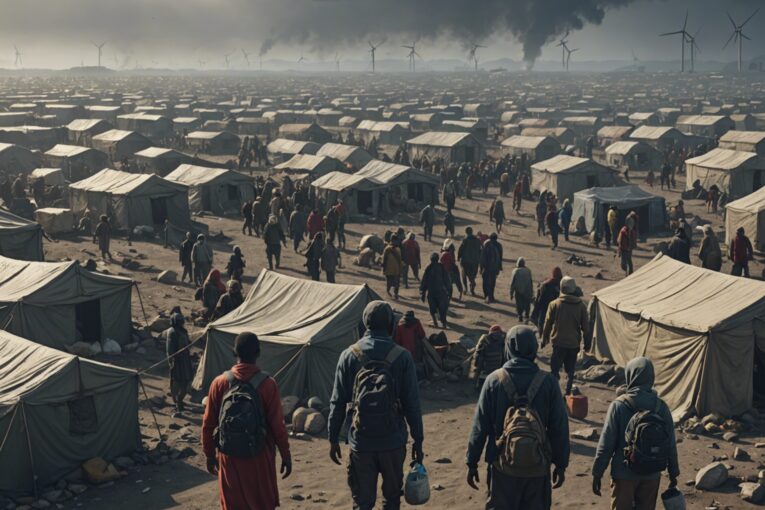Introduction
The small island nation of Tuvalu in the South Pacific is slowly sinking into the ocean. Rising sea levels have already swallowed several small islands, and the country faces complete submersion by 2050.
As their homes disappear under the waves, Tuvaluans are left with a terrible choice: stay and face oblivion, or become climate refugees, fleeing to foreign lands that increasingly see them as illegal immigrants.
Problem Statement
The UNHCR defines a refugee as someone who, “owing to a well-founded fear of persecution, is unable to return home.” But what of those who can never return home because their home no longer exists? There is no legal definition protecting “climate refugees” displaced specifically by climate change impacts.
Existing asylum frameworks fail to account for the unprecedented scale of migration driven by a destabilized climate. Urgent legal reform is needed to close this gap and recognize climate displacement as valid grounds for asylum.
There are two main approaches to securing legal protection for climate refugees:
- Adapt existing asylum frameworks by expanding established definitions of asylum eligibility to include environmental factors and climate displacement.
- Develop new legal tools: Creating specialized regional agreements, commissions, or conventions to coordinate relief efforts and facilitate migration pathways.
Climate change is fundamentally challenging how we address human mobility and border security. Closing the legal gaps around climate displacement requires adapting existing norms and developing new collaborative governance tools better equipped to handle a shifting planet.
The Limits of Existing Asylum Law
The 1951 Refugee Convention
The 1951 Refugee Convention forms the basis of modern asylum law by establishing core principles like non-refoulement protection from return to dangerous countries.
However, the Convention only recognizes asylum eligibility based on persecution due to race, religion, nationality, political opinion or membership of a social group. Environmental factors are not included, though they are increasingly driving cross-border migration.
As climate change accelerates, millions risk displacement without legal cover under existing frameworks like the 1951 Convention.
Relevant resource: The 1951 Refugee Convention Explained
Case Studies
Individuals displaced by climate change have struggled to gain refugee status due to narrow definitions focusing on targeted violence. For example:
- In 2020, a Tuvalu family was denied New Zealand asylum despite rising seas threatening Tuvalu’s very existence.
- In 2015, a Kiribati man in New Zealand claimed changing rain patterns and infertile soil had ended traditional farming. His case was rejected for lacking political persecution.
UN Human Rights Committee Ruling
In January 2023, the UN Human Rights Committee issued a landmark advisory ruling in the Teitiota case regarding an individual from Kiribati who denied New Zealand asylum.
The ruling states that countries may violate human rights commitments if they deport individuals to countries severely impacted by the climate crisis where survival and basic needs cannot be guaranteed.
While non-binding, the ruling signifies growing momentum for expanding legal protection based on climate-driven displacement.
Relevant resource: UN Calls for Legal Protection of Climate Refugees
Expanding Asylum Definitions: A Call for Adaptation
Environmental Displacement Framework
Some legal experts argue existing asylum law can adapt to cover climate displacement by formally recognizing “environmental displacement” as a category triggering protection obligations.
This approach proposes structuring asylum claims based on three elements:
- Severe environmental disruption makes return impossible
- State failure to address the environmental harm
- The individual faces serious risks involving basic survival and human rights
Framing displacement cases through an environmental lens makes the asylum process accessible while working within established legal precedent.
Persecution by Proxy
Another approach argues that while climate change itself does not directly persecute people, government inaction enables indirect persecution by climate change over time.
Under this “persecution by proxy” concept, an asylum claim could argue that worsening climate impacts expose citizens to harm due to deliberate state negligence. Failing infrastructure and non-existent climate adaptation plans indirectly persecute citizens, denying them basic safety and dignity.
So instead of targeting individuals, climate change targets populations and entire societies based on geography, transforming status from passive victim to persecuted group. Those fleeing dead zones of climate chaos deserve protected status.
Challenges and Criticisms
Expanding asylum definitions raises valid concerns regarding fair borders and systems not designed to handle millions of new refugees. Lowering the threshold for “persecution by proxy” risks exploitable ambiguity and placing unreasonable burdens on authorities.
Furthermore, focusing on individual asylum applications fails to tackle the underlying collective crisis. Case-by-case band-aids cannot treat systemic wounds.
Relevant resource: Should Climate Change Refugees Be Granted Asylum?
Creating New Legal Frameworks: Building on Existing Tools
The Global Compact for Migration
150 countries have endorsed the 2018 Global Compact for Safe, Orderly, and Regular Migration, which has provisions that specifically address disaster displacement and climate risks.
Objective 2 seeks to “minimize the adverse drivers and structural factors that compel people to leave their country,” including natural disasters, degradation, and climate change adaptation support.
While the Compact itself is non-binding, it signals a global consensus on facilitating climate migration pathways via collective response.
Relevant resource: About the Global Compact for Migration
Regional Agreements
Binding regional agreements and multi-country commissions represent another approach to enhance protection and coordinate resettlement for climate migrants.
Tailored frameworks can account for region-specific climate impacts and projections, especially regarding slow-onset changes and extreme weather events. Special provisions may cover temporary relocation after disasters or planned relocation to avoid uninhabitable zones.
For example, the African Union Convention on IDP Protection obligates states to protect and assist individuals internally displaced by natural disasters. A similar convention addressing cross-border climate displacement could emerge in heavily impacted regions.
The Nansen Initiative
Launched in 2012 by Switzerland and Norway, the Nansen Initiative convened states and civil society groups to address cross-border displacement risks following sudden-onset disasters across regions.
The resulting Nansen Agenda outlined overarching principles and best practices for managing disaster-driven migrant flows, serving as a blueprint that could be expanded to cover climate scenarios.
Relevant resource: About the Nansen Initiative
Conclusion
Climate change presents society with a moral reckoning; how we choose to treat those fleeing devastated homelands speaks to our shared humanity.
We must balance compassion with pragmatism to navigate this complex crisis. Expanding individual asylum pathways has limits, while regional coordination mechanisms remain untested on this unprecedented scale.
Yet if nations collaborate creatively to close gaps in protecting climate refugees, it offers hope of restoring dignity for the displaced and affirming global solidarity in the face of the historic challenges ahead. The time for action is now.
FAQ: Navigating the Legal Landscape for Climate Refugees
No universally recognized legal definition or special status exists for climate refugees. Individuals displaced across borders due to climate impacts would need to file traditional asylum claims. Success depends on proving targeted persecution rather than inability to survive in their home country.
Experts propose two main approaches: expanding existing asylum laws to incorporate environmental factors or creating new regional agreements specifically addressing cross-border climate displacement scenarios. Combining temporary protection status after disasters with planned relocation programs could also help relieve pressure on struggling states.
Projections vary greatly, from 25 million to 1 billion climate migrants by 2050, according to different estimates. However, focusing too much on raw numbers obscures the human trauma and inherent rights violations suffered by all those forcibly displaced against their will.





